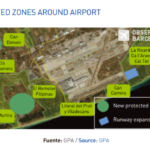
#40 - BARCELONA AIR TRAFFIC INTELLIGENCE UNIT - Quarterly Report July 2021 (4/5)
The Barcelona airport has a maximum capacity of 55 M passengers per year, on the basis of its current infrastructure. In 2019, 52.7 M passengers were reached. Given the situation linked to the decrease in traffic during 2020 due to the COVID-19 pandemic, it is expected that the saturation point will be reached in 2026. For this reason, it is important to undertake a new expansion asap.
The expansion recently presented by AENA is based on two main actions: The construction of the satellite terminal and the 500m extension of the “sea” runway through the 25L. These actions would allow reaching a maximum capacity of 70M passengers per year and between 80-90 movements per hour.
Currently the preferred configuration is the one marked in orange in the figure. Take-offs are normally carried out by the “sea” runway (07R-25L), with a turn towards the sea after takeoff to reduce the acoustic impact on Gavà Mar. Except in some situations where the aircraft need more runway length and then it is required to take off from the “land” runway (07L-25R); for example, in summer with a widebody aircraft and maximum weight. These runway change situations reduce the optimal operation of the airport.
The expansion of the “sea” runway at the 25L would provide a system of two parallel runways with the same length. Allowing an earlier turn towards the sea, it would further reduce the acoustic impact on the Gavà Mar area and Castelldefels.
The area that would be affected by the expansion of runway 25L corresponds to the Ricarda wetland area, which is a protected natural area of the Natura 2000 Network and also a ZEPA (special bird protection area).
AENA proposes a series of compensatory measures to expand the protected area by an additional 25%, compensating the affected habitats with new protected areas on the basis of a 1:10 ratio.
Source:
Chamber of Commerce of Barcelona
ACI/Aena/ADI/GPA/IATA/MIDT










